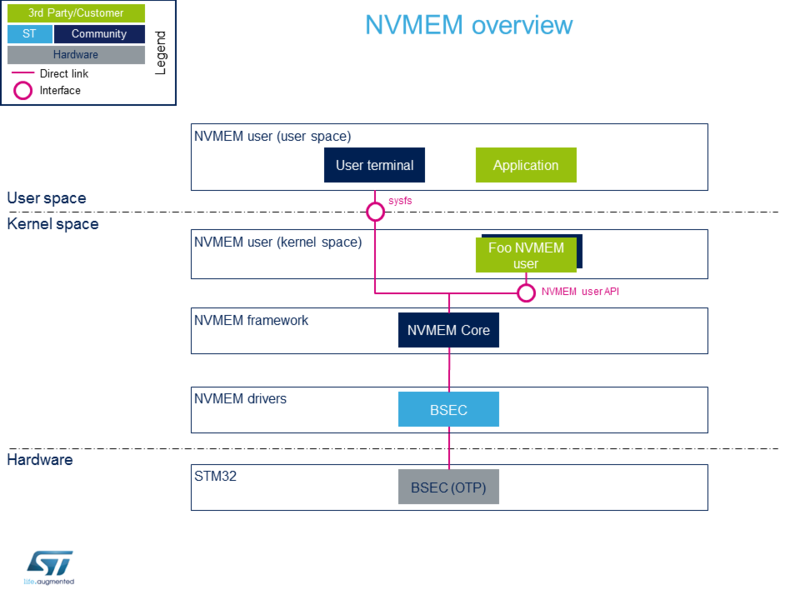This article introduces how NVMEM Linux® framework manages BSEC OTP data and how to read/write from/to it.
1. Framework purpose[edit source]
The NVMEM Linux® framework provides a generic interface for the device non-volatile memory data such as:
- OTP (one-time programmable) fuses
- EEPROM
It offers kernel space and user space interfaces to read and/or write data such as analog calibration data or MAC address.
2. System overview[edit source]
2.1. Component description[edit source]
- NVMEM user (user space)
The user can use the NVMEM sysfs interface, from a user terminal or a custom application, to read/write data from/to NVMEM device(s) from user space.
- NVMEM user (kernel space)
User drivers can use the NVMEM API to read/write data from/to NVMEM device(s) from kernel space (such as the analog calibration data used by an ADC driver).
- NVMEM framework (kernel space)
The NVMEM core provides sysfs interface and NVMEM API. They can be used to implement NVMEM user and NVMEM controller drivers.
- NVMEM drivers (kernel space)
Provider drivers such as BSEC Linux® driver that exposes OTP data to the core.
- NVMEM hardware
NVMEM controller(s) such as the BSEC internal peripheral[1]
2.2. API description[edit source]
The NVMEM kernel documentation[2] describes:
- Kernel space API for NVMEM providers and NVMEM consumers.
- Userspace binary interface (sysfs).
See also sysfs-bus-nvmem[3] ABI documentation.
3. Configuration[edit source]
3.1. Kernel configuration[edit source]
Activate NVMEM framework in the kernel configuration through the Linux® menuconfig tool, Menuconfig or how to configure kernel (CONFIG_NVMEM=y):
Device Drivers --->
[*] NVMEM Support --->
<*> STMicroelectronics STM32 factory-programmed memory support
3.2. Device tree configuration[edit source]
The NVMEM data device tree bindings[4] describe:
- The location of non-volatile memory data
- The NVMEM data providers
- The NVMEM data consumers
The BSEC internal peripheral[1] device tree bindings are explained in BSEC device tree configuration article.
4. How to use the framework[edit source]
4.1. How to use NVMEM with sysfs interface[edit source]
4.1.1. How to list NVMEM devices[edit source]
The available NVMEM devices can be listed in sysfs:
# Example to list nvmem devices
ls /sys/bus/nvmem/devices/
stm32-romem0
The data content of an NVMEM device can be dumped to a binary file, and then displayed.
4.1.2. How to read BSEC lower OTPs using NVMEM[edit source]
The 32 lower OTPs can be read from non-secure when using either:
- the trusted boot chain (using TF-A)
- the basic boot chain (using U-Boot SPL)
# Example to read lower nvmem data content dd if=/sys/bus/nvmem/devices/stm32-romem0/nvmem of=/tmp/file bs=4 count=32 # Example to display nvmem data content hexdump -C -v /tmp/file
4.1.3. How to read BSEC upper OTPs using NVMEM[edit source]
Default behavior for upper OTPS is normally restricted to security. If user needs more than the 32 lower OTPs, there is an exception management explained in BSEC device tree configuration.
It is then possible to access to some upper NVMEM information.
# Example to read the MAC address from upper OTP area, using secure services:
dd if=/sys/bus/nvmem/devices/stm32-romem0/nvmem of=/tmp/file skip=57 bs=4 count=2 status=none
hexdump -C -v /tmp/file
4.1.4. How to write BSEC OTPs using NVMEM[edit source]
Whatever the boot chain, the full lower NVMEM data content can be written as follows (if we suppose it has been previously read as described above, and updated directly in /tmp/file):
# Example to write lower nvmem data content
dd if=/tmp/file of=/sys/bus/nvmem/devices/stm32-romem0/nvmem bs=4 count=32
Only on Trusted boot chain, and under the condition the device tree authorizes it, an upper NVMEM data can be written.
Example of 32-bit data word writing (filling it with ones) in OTP n°95:
# Create a 4 bytes length file filled with ones, e.g. 0xffffffff)
# Then, write it (32-bits, e.g. 4bytes) to OTP data 95
dd if=/dev/zero count=1 bs=4 | tr '\000' '\377' > file
dd if=file bs=4 seek=95 of=/sys/bus/nvmem/devices/stm32-romem0/nvmem
5. How to trace and debug the framework[edit source]
5.1. How to trace[edit source]
Ftrace can be used to trace the NVMEM framework:
cd /sys/kernel/debug/tracing cat available_filter_functions | grep nvmem # Show available filter functions rtc_nvmem_register rtc_nvmem_unregister nvmem_reg_read bin_attr_nvmem_read ...
Enable the kernel function tracer, then start using nvmem and display the result:
echo function > current_tracer echo "*nvmem*" > set_ftrace_filter # Trace all nvmem filter functions echo 1 > tracing_on # start ftrace hexdump -C -v /sys/bus/nvmem/devices/stm32-romem0/nvmem # dump nvmem 00000000 17 00 00 00 01 80 00 00 00 00 00 00 00 00 00 00 |................| ... echo 0 > tracing_on # stop ftrace cat trace # tracer: function # # _-----=> irqs-off # / _----=> need-resched # | / _---=> hardirq/softirq # || / _--=> preempt-depth # ||| / delay # TASK-PID CPU# |||| TIMESTAMP FUNCTION # | | | |||| | | hexdump-478 [000] .... 423.502278: bin_attr_nvmem_read <-sysfs_kf_bin_read hexdump-478 [000] .... 423.502290: nvmem_reg_read <-bin_attr_nvmem_read hexdump-478 [000] .... 423.515804: bin_attr_nvmem_read <-sysfs_kf_bin_read
6. References[edit source]
- ↑ Jump up to: 1.0 1.1 BSEC internal peripheral
- ↑ Documentation/nvmem/nvmem.txt , NVMEM subsytem kernel documentation
- ↑ Documentation/ABI/stable/sysfs-bus-nvmem , NVMEM ABI documentation
- ↑ Documentation/devicetree/bindings/nvmem/nvmem.txt , NVMEM data device tree bindings
